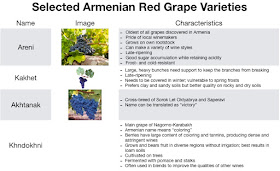The Armenia of yore was associated with Urartu, a Kingdom which saw its heyday during the 9th and 8th Centuries BC. Inscriptions from that time show the Urartan kings referring to Armenia as "the land of the vineyards" (Smithsonian Magazine).
Up until 1915, Greater Armenia included much of today's Eastern Turkey; and Mount Ararat lay at its center, rather than within the Turkish borders. According to the Book of Genesis, it is on the Mount of Ararat that Noah planted the first vineyard and became the first winelover to become drunk on the fruit of the vine.
Further, as I have pointed out in my post on the origins of viticulture, in 2010, researchers with UCLA and the Armenian Institute of Archaeology and Ethnography unearthed evidence of the world's oldest known winery in the village of Areni in southwestern Armenia. "Beneath a layer of sheep manure inside a cave, the remains of crushed grapes and vessels for collecting and fermenting grape juice, dating to 6100 years ago, were discovered. This proved that humans produced wine systematically 1000 years earlier than thought" (Smithsonian Magazine).
Winemaking equipment consisted of a 2-foot deep vat buried next to shallow, 3.5-foot-long basin made of hard-packed clay with elevated edges. This suggests foot-treading of grapes with the juice from the trampled grapes drained into the vat where it was left to ferment. The wines at Areni-1 were stored in jars post-fermentation where the cool, dry conditions of the cave resulted in perfect wine cellaring conditions. Traces of a grape used in red wine production today were found on pot sherds at the excavation site providing a new link between ancient and modern wine production (Smithsonian Magazine).
So, clearly, Armenia had a historical winemaking pedigree. No less a person than the historian Herodotus reported that, even though Assyria grew grapes and made wine, Babylon purchased wine from Armenia.
Winemaking in Armenia fell of the radar screen until 1887 when the merchant Nersis Tairov established the first wine and cognac production plant in the former Erivan fortress. The venture was sold to the Russian manufacturer Shustov in 1898.
In the modern era, Soviet rule almost erased traditional winemaking from Armenian culture. The Soviet emphasis was on specialization and quantity over quality and, from the 1930s through the 1990s, Armenian winemakers were directed to produce fortified wines and brandies rather than the traditional Armenian table wines.
It was not until the late 1990s that we began to see a resurgence in Armenian winemaking.
Armenia is a landlocked country that is 29,700 sq. km in size. Its wine reflects the country's exceptional terroir:
- It has some of the highest grape-growing elevations in the northern hemisphere
- Altitudes range between 420 and 1750 m; some smaller vineyards are at 2000 m
- Results in a high concentration of polyphenols in the grapes
- Lends the wine a higher structure and an elegance similar to the wines from Northern Italy
- Extreme continental climate breeds grapes with high acidity
- Diverse microclimates
- Hillsides and valleys
- Mostly southern, southeastern, and some eastern aspects
- Rich volcanic soils; some sedimentary and sandy rocks.
I will continue with winemaking in my next post.
©Wine -- Mise en abyme






No comments:
Post a Comment